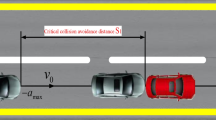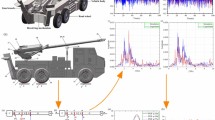Abstract
Car-following models seek to describe the behaviour of a group of vehicles as they move along a stretch of road. In such models the behaviour of each vehicle is taken to be dependant on the motion of the vehicle in front and overtaking is not permitted. In this paper the effect of removing this ‘no-overtaking’ restriction is investigated. The resulting model is described in terms of a set of coupled time delay differential equations and these are solved numerically to analyse their post-transient behaviour under a periodic perturbation. For certain parameter choices this behaviour is found to be chaotic, and the degree of chaos is estimated using the Grassberger–Procaccia dimension.
Similar content being viewed by others
References
Brackstone, M., McDonald, M.: Car following: A historical review. Trans. Res. Part F Traffic Psychol. Behav. 2, 181–196 (2000)
Gazis, D.C.: Traffic Theory. Kluwer Academic, Dordrecht (2002)
Bando, M., Hasebe, K., Nakayama, A., Shibata, A., Sugiyama, Y.: Dynamical model of traffic congestion and numerical simulation. Phys. Rev. E 51, 1035–1042 (1995)
Bando, M., Hasebe, K., Nakanishi, K., Nakayama, A.: Analysis of optimal velocity model with explicit delay. Phys. Rev. E 58, 5429–5435 (1998)
Wilson, R.E., Berg, P., Hooper, S., Lunt, G.: Many neighbour interactions and non-locality in traffic models. Eur. Phys. J. B 39, 397–408 (2004)
Orosz, G., Wilson, R.E., Krauskopf, B.: Global bifurcation investigation of an optimal velocity model with driver reaction time. Phys. Rev. E 70, 026207 (2004)
McCartney, M.: A trip time model for traffic flow on a semi-closed loop. Transp. Res. B (2007, submitted)
Gibson, S., McCartney, M.: Investigating a class of car following model on a ring. In: Heydecker, B. (ed.) Mathematics in Transport, pp. 97–109. Elsevier, Amsterdam (2007)
McCartney, M., Gibson, S.: Differential equations, traffic dynamics and the N roots of unity. Math. Gaz. 90, 502–505 (2006)
McCartney, M., Gibson, S.: The routes of unity. Int. J. Math. Educ. Sci. Technol. 37, 992–997 (2006)
Gazis, D.C., Herman, R., Rothery, R.W.: Nonlinear follow-the-leader models of traffic flow. Oper. Res. 9, 545–567 (1961)
Jarrett, D., Xiaoyan, Z.: The dynamic behaviour of road traffic flow: stability or chaos? In: Crilly, A.J., Earnshaw, R.A., Jones, H. (eds.) Applications of Fractals and Chaos. Springer, Berlin (1993)
Addison, P.S., Low, D.J.: A novel nonlinear car-following model. Chaos 8, 791–799 (1998)
Low, D.J., Addison, P.S.: A nonlinear temporal headway model of traffic dynamics. Nonlinear Dyn. 16, 127–151 (1998)
Sprott, J.C.: Chaos and Time-Series Analysis. Oxford University Press, London (2003)
Hilborn, R.C.: Chaos and Nonlinear Dynamics, 2nd edn. Oxford University Press, London (2000)
Addison, P.S.: Fractals and Chaos: An Illustrated Course. Institute of Physics, Bristol (1997)
Grassberger, P., Procaccia, I.: Characterisation of strange attractors. Phys. Rev. Lett. 50, 346–349 (1983)
Grassberger, P., Procaccia, I.: Measuring the strangeness of strange attractors. Physica D 9, 189–208 (1983)
Chandler, F.E., Herman, R., Montroll, E.W.: Traffic dynamics: studies in car following. Oper. Res. 6, 165–184 (1958)
Toledo, B.A., Munoz, V., Rogan, J., Tenreiro, C.: Modeling traffic through a sequence of traffic lights. Phys. Rev. E 70, 016107 (2004)
Kesting, A., Treiber, M., Helbing, D.: General lane-changing model MOBIL for car-following models. Transp. Res. Rec. 1999, 86–94 (2007)
Laval, J.A., Daganzo, C.F.: Lane-changing in traffic streams. Transp. Res. B 40, 251–264 (2006)
Lan, L.W., Lin, F.Y., Kuo, A.Y.: Identification for chaotic phenomena in short term traffic flows: A parsimony procedure with surrogate data. J. East. Asia Soc. Transp. Stud. 6, 1518–1533 (2005)
Author information
Authors and Affiliations
Corresponding author
Rights and permissions
About this article
Cite this article
Jamison, S., McCartney, M. A velocity matching car-following model on a closed ring in which overtaking is allowed. Nonlinear Dyn 58, 141–151 (2009). https://doi.org/10.1007/s11071-009-9467-2
Received:
Accepted:
Published:
Issue Date:
DOI: https://doi.org/10.1007/s11071-009-9467-2




